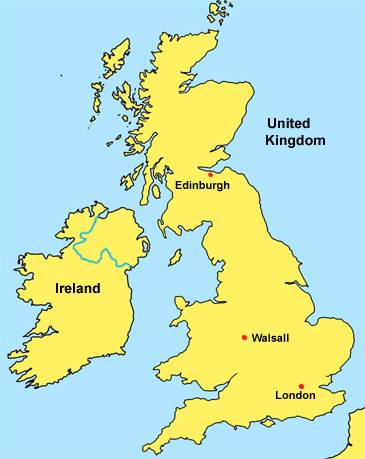 Chris Korte's New Zealand Genealogy Project
Chris Korte's New Zealand Genealogy Project
Walsall, Staffordshire, England
About page
This page provides information about Walsall, Staffordshire, England. Alfred Trueman (1853-1932) and some of his younger siblings were born in Walsall and spent their early life there before immigrating to New Zealand with their parents in 1857. Alfred's father Henry Trueman was a bootmaker in Walsall. The family lived in Intown Row, in Walsall town centre (residences now demolished).
If you can provide additional information, or corrections, please contact (see Info menu).
Walsall
Walsall is a large industrial town in the West Midlands of England. It is located 8 miles northwest of Birmingham and 6 miles east of Wolverhampton. Historically it was part of Staffordshire. Walsall is the administrative headquarters of the Metropolitan Borough of Walsall. In the 2011 census, the town's built-up area had a population of 67,600.
The Industrial Revolution changed Walsall from a village of 2,000 people in the 16th century to a town of over 86,000 in approximately 200 years. The town manufactured a wide range of products including saddles, chains, buckles and plated ware. Nearby, limestone quarrying provided the town with much prosperity.

19th Century Walsall
The following is from History, Gazetteer and Directory of Staffordshire, William White, Sheffield, 1851.
The PARISH OF WALSALL is in two townships, called Borough and Foreign, and had only 10,399 inhabitants in 1801, but in 1821 its population had increased to 11,914; in 1831 to 15,064; in 1841 to 20,852; and in 1851 to 26,816 souls, of whom 8760 were in the Borough, and 18,056 in the Foreign Township. More than two thirds of the latter are in the suburbs of Walsall, and the rest in the large village of Bloxwich, and the hamlets of Birch Hills, Walsall Wood, Shelfield, Goscote, Caldmore & c., extending four miles north and one and a half miles south of the town, as afterwards noticed. The Borough township contains only about 100 acres, but the 'Foreign of Walsall' extends over more than 8000 acres, and includes several large collieries and iron works. RYECROFT, a northern suburb of the town, is in Rushall parish.
The great increase in the population during the last 20 years is attributable to the prosperity of the staple manufactures of the town, and to the opening of several coal, iron, and limestone mines, in the neighbourhood. WALSALL UNION comprises eight townships and 43,038 souls, as afterwards noticed. The PARLIAMENTARY BOROUGH of Walsall comprises all the parish, except a detached portion of the Foreign Township, called Walsall Wood and Shelfield, which contains about 1200 inhabitants, chiefly miners. The MUNICIPAL BOROUGH comprises the whole parish, and is now divided into three wards.
The Earl of Bradford is Lord of the Manor of Walsall, which comprises nearly all the parish, but a great part of the soil belongs to Lord Hatherton, John Crowther Esq., (owner of Goscote,) a number of other freeholders, and many copyholders, the latter of whom hold by a very easy tenure, paying only a few pence annually to the lord, and being in some respects superior to freeholders, as they can sell their estates without any restriction, as it respects dower, and without the great expense of suing for fines in the superior courts of London.
About two centuries ago, Walsall was a place of much greater importance than its now gigantic neighbour, Birmingham, which was then described as 'a hamlet near Walsall'.
Among the staple manufactures of Walsall, are buckles, chains, curbs, bits, spurs, stirrups, plated and other mountings, bridles, saddles, harness, collars, etc, and every description of saddlers' and coachmakers' ironmongery, for which Walsall stands unrivalled, both in the variety and excellence of its productions. Locks, keys, snuffers, brushes, spectacles, and a variety of other articles, are also manufactured here, and in the town are a number of iron and brass foundries, and in the parish several extensive coal, iron, and lime works, the latter of which are on the north-east side of the town, adjoining those of Rushall.
Page last updated on 29 July 2018.







